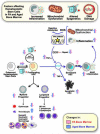Fanconi Anemia: A DNA repair disorder characterized by accelerated decline of the hematopoietic stem cell compartment and other features of aging
- PMID: 27223997
- PMCID: PMC5114166
- DOI: 10.1016/j.arr.2016.05.005
Fanconi Anemia: A DNA repair disorder characterized by accelerated decline of the hematopoietic stem cell compartment and other features of aging
Abstract
Fanconi Anemia (FA) is a rare autosomal genetic disorder characterized by progressive bone marrow failure (BMF), endocrine dysfunction, cancer, and other clinical features commonly associated with normal aging. The anemia stems directly from an accelerated decline of the hematopoietic stem cell compartment. Although FA is a complex heterogeneous disease linked to mutations in 19 currently identified genes, there has been much progress in understanding the molecular pathology involved. FA is broadly considered a DNA repair disorder and the FA gene products, together with other DNA repair factors, have been implicated in interstrand cross-link (ICL) repair. However, in addition to the defective DNA damage response, altered epigenetic regulation, and telomere defects, FA is also marked by elevated levels of inflammatory mediators in circulation, a hallmark of faster decline in not only other hereditary aging disorders but also normal aging. In this review, we offer a perspective of FA as a monogenic accelerated aging disorder, citing the latest evidence for its multi-factorial deficiencies underlying its unique clinical and cellular features.
Keywords: Aging; Bone marrow failure; DNA repair; Epigenetic; Fanconi Anemia; Hematopoietic stem cells; Inflammatory response; Oxidative stress; Telomere.
Published by Elsevier B.V.
Figures


References
-
- Alter BP. Cancer in Fanconi anemia, 1927-2001. Cancer. 2003;97:425–440. - PubMed
-
- Alvarez S, Diaz M, Flach J, Rodriguez-Acebes S, Lopez-Contreras AJ, Martinez D, Canamero M, Fernandez-Capetillo O, Isern J, Passegue E, Mendez J. Replication stress caused by low MCM expression limits fetal erythropoiesis and hematopoietic stem cell functionality. Nat. Commun. 2015;6:8548. - PMC - PubMed
-
- Bagby GC., Jr. Genetic basis of Fanconi anemia. Curr. Opin. Hematol. 2003;10:68–76. - PubMed
-
- Barja G. The mitochondrial free radical theory of aging. Prog. Mol. Biol. Transl. Sci. 2014;127:1–27. - PubMed
Publication types
MeSH terms
Substances
Grants and funding
LinkOut - more resources
Full Text Sources
Other Literature Sources
Medical

